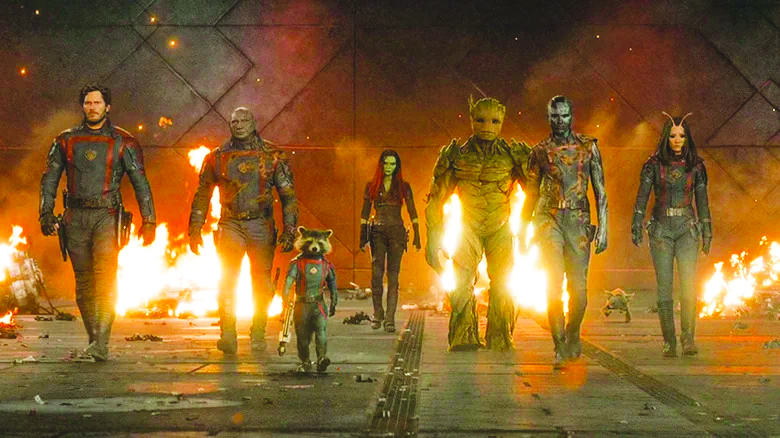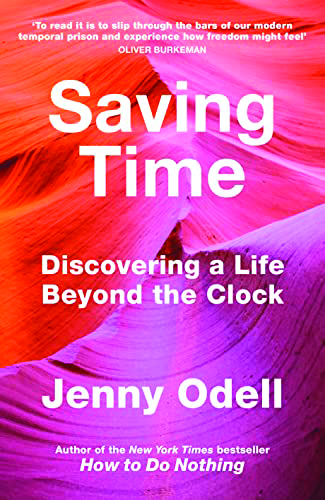Peter Quill and the gang return for one last? (probably not) hurrah in Guardians of the Galaxy Vol. 3 — not the worst Marvel Cinematic Universe movie, but not nearly as fun as the The Marvels trailer that preceded it.
This outing is largely Rocket’s (voice of Bradley Cooper) story, though he is often separated from the main group, so we don’t get a lot of his cranky raccoon personality or the group dynamic that was such a big part of the first outing. We meet up with the gang hanging out on Knowhere, doing Guardians work and trying to help a depressed and frequently drunk Peter/Star-Lord (Chris Pratt), who still hasn’t gotten over the loss of his Gamora (Zoe Saldaña) back in Infinity War.
Adam Warlock (Will Poulter), a powerful but stupid creation of the Sentinels (think “golden Elizabeth Debicki” from the second Guardians), shows up to steal away Rocket. The gang — Groot (voice of Vin Diesel), Mantis (Pom Klementieff), Drax (Dave Bautista), Nebula (Karen Gillan) — manages to keep Rocket from being Warlock-napped but he’s grievously injured and attempts to heal him uncover that Rocket is, essentially, password protected. The crew sets off to find the lab where Rocket’s enhancements were engineered to get his system unlocked and make him capable of being healed. This puts them in the path of The High Evolutionary (Chukwudi Iwuji), a powerful nutcase whose experiments have resulted in a variety of strange species, from the golden Sentinels (who were trying to steal Rocket for him) to animals like Rocket with tortuously applied extra limbs and abilities to a planet of humanoid animals that have, like, rabbit faces but otherwise mow the lawn and drive 1980s-model sedans and stuff.
The alternate-universe Gamora, who was stuck in the present after Endgame and who is now a professional thief with Sylvester Stallone and crew, joins up with the Guardians gang to head to the High Evolutionary’s base of operations to search for the Rocket password. She may not have the same emotional connection to Peter and the others but she also finds herself fighting to unlock Rocket’s password and protect him from the High Evolutionary henchmen trying to steal him. It seems that Rocket and his abilities to learn and think for himself represents the HE’s most promising technological achievement and he wants Rocket’s brain to help him engineer another super species.
I know that all sounds like a lot of plot, but somehow it isn’t. It’s like rice cakes — seems large but there’s not actually a lot to it when you dig in. This movie has a lot of ideas but not much in the way of fully developed story; it’s more like pieces of “oh, and maybe they could” glued together, kind of the way you do with a project where you don’t have a really clear focus and so you just keep adding “more” until it looks big enough.
I think the writers’ strike and the accompanying A.I. talk probably put this fear out into the ether, but what I felt very quickly while watching this movie was that this was the kind of movie we’re all afraid we’ll get if A.I. starts writing films. Like, it seems Marvel-ish, it has lines that feel like jokes, it has a line up of well known songs for the soundtrack, it has the general vibe of its creator having seen previous Guardians movies. But there is that Uncanny Valley, timing-not-quite-right feel to it — to the quips, to the physical humor, to the emotional beats, to the music. If this movie were a person it would be blinking both not enough and then suddenly too much.
James Gunn, human writer on all the previous Guardians movie (and the loveably goofy Christmas special), is the writer and director here. Why the movie feels like it was more lab grown than organically created, I’m not sure. Maybe it’s trying to do too much? It puts Rocket at the center but still tries to give us Peter’s story and his relationship woes and tell the story of the group and its development, and it seeks to establish this very bonkers villain who either needed to dial it back or just turn the knob all the way up. (As is, the HE is just kind of a forgettable nothing.) And there’s some character development for Mantis that gets worked in even though it feels like the movie doesn’t really have time for it.
What made the first Guardians movie and these characters a delight was the shagginess of them — generally, they’re not the best or the brightest and they are frequently jerks to each other, but they were scruffily likable and had their adventures in a more fantastical space setting than, like, the Iron Man/Captain America top-shelf part of the MCU. While Vol. 3 keeps us in a land of odd creatures and big colors, the charm and the low-fi fun are mostly gone and have been replaced with something too processed to let its characters have memorable moments or its story to really pop. C
Rated PG-13 for intense sequences of violence and action, strong language, suggestive/drug references and thematic elements, according to the MPA on filmratings.com. Written and directed by human person James Gunn, who is I guess bound for DC now, Guardians of the Galaxy Vol. 3 is two hours and 29 minutes long and is distributed in theaters by Walt Disney Studios Motion Pictures.
Are You There God? It’s Me, Margaret. (PG-13)
A 12-year-old comes home to New York City from a happy summer at camp to learn that her family is moving to the New Jersey suburbs and all the horrors of sixth grade will be experienced with new kids at a new school in Are You There God? It’s Me, Margaret, a very sweet, 1970s-set adaptation of Judy Blume’s classic novel.
Margaret (Abby Ryder Fortson), only child of Barbara (Rachel McAdams) and Herb Simon (Benny Safdie), likes living in the city, near her beloved grandmother Sylvia (Kathy Bates). She’s nervous about what this new place and these new kids will be like. On arriving in New Jersey, she’s sort of claimed by neighbor girl Nancy (Elle Graham), also a sixth-grader, who will be in Margaret’s class. Nancy has queen-bee-ed herself to the leader position in a foursome of girls that now includes Margaret as well as Janie (Amari Alexis Price) and Gretchen (Katherine Mallen Kupferer). She demands that this club concern themselves with bras, periods and the boys they like, a list she insists begins and ends with Philip (Zachary Brooks), a boy in their class.
Margaret, though, is quickly charmed by Moose (Aidan Wojtak-Hissong), friend of Nancy’s slightly older brother Evan (Landon Baxter). And, informed by the lady in the department store that she doesn’t really need a bra, Margaret finds that she’s been talked into wearing a very uncomfortable “grow bra.” Please, she prays to/begs of God, please let her chest grow and let her get her period and be normal and regular like everybody else — except of course the only “everybody” who really seems to be in that boat is a girl named Laura (Isol Young), who is living out her own tween hell thanks to Nancy’s unfriendly comments.
Meanwhile, underneath all the “why, God, why?” of being 12, Margaret is dealing with something of a religious struggle after learning some difficult aspects of her family’s history. Barbara never talks with her strict Christian parents — and Margaret has never met them — because they cut Barbara off when she married Herb, who is Jewish. Neither Barbara nor Herb has ever imparted religion on Margaret, saying she can decide for herself when she grows up. But now Margaret has decided that she’d like to decide — trying out synagogue with her grandmother and church with some of her friends and hoping she’ll feel something that will let her know “what she is.” Along the way, she talks to God — pouring out fears and general anxieties about, you know, 12.
I don’t remember how much of this is in the book but in between elements of Margaret’s story we get these little peeks at Barbara’s story and her struggles and changes. She has gone from being a working mother in the city to a stay-at-home mother in the suburbs. She is also dealing with going from being a mother to a kid to being a mother to a tween girl who is gently trying out aspects of teenage-ness and looking for bits of independence. This might be one of those things you notice more depending on where you, the viewer, are personally, age- and life-circumstance-wise, but I enjoyed how the movie gave us Barbara’s struggles and her attempts to find her place in this new environment. McAdams fills in this character so nicely, giving us so much context to who Barbara is with just a facial expression.
To a smaller degree, we also get little glimpses of Sylvia’s life and her changes. With her family no longer nearby in the city, she’s sort of rearranging her identity. Margaret’s independence and her distance mean changes for Sylvia too — eventually leading to an extended trip to Florida — which is just a neat aspect to see examined, even just briefly.
But what this movie really does best, I think, is get to that “please let me be normal” desperation at an age when there really is no “normal.” Fortson is a winning Margaret — selling Margaret as a kid and Margaret as a teen, Margaret as a willing follower and Margaret as someone who knows how to stand up for herself. The character can take you right back to your tween self while the movie offers gentle character studies of multiple generations. B+
Rated PG-13 for thematic material involving sexual education (or really, the lack of sexual education by these girls who have to rely on a stolen anatomy book and a school health class) and some suggestive material, according to the MPA on filmratings.com. Written and directed by Kelly Fremon Craig, Are You There God? It’s Me, Margaret is an hour and 46 minutes long and is distributed in theaters by Lionsgate.
Featured photo: Guardian of the Galaxy Vol. 3






